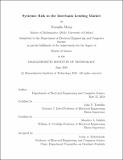| dc.contributor.advisor | John N. Tsitsiklis and Munther A. Dahleh. | en_US |
| dc.contributor.author | Meng, Xianglin (Scientist in electrical engineering and computer science) Massachusetts Institute of Technology | en_US |
| dc.contributor.other | Massachusetts Institute of Technology. Department of Electrical Engineering and Computer Science. | en_US |
| dc.date.accessioned | 2018-09-17T14:50:46Z | |
| dc.date.available | 2018-09-17T14:50:46Z | |
| dc.date.copyright | 2018 | en_US |
| dc.date.issued | 2018 | en_US |
| dc.identifier.uri | http://hdl.handle.net/1721.1/117814 | |
| dc.description | Thesis: S.M., Massachusetts Institute of Technology, Department of Electrical Engineering and Computer Science, 2018. | en_US |
| dc.description | This electronic version was submitted by the student author. The certified thesis is available in the Institute Archives and Special Collections. | en_US |
| dc.description | Cataloged from student-submitted PDF version of thesis. | en_US |
| dc.description | Includes bibliographical references (pages 77-81). | en_US |
| dc.description.abstract | Our goal is to understand the functioning of the interbank lending market in times of market stress. Working towards this goal, we conduct theoretical analysis and simulation to study the effects of network structure and shock scenarios on systemic risk in the market. We consider shocks of various sizes at both global and local scales. In terms of risk measures, we study relative systemic loss and the default rate, separating the latter quantity into fundamental default and contagion. Our simulations suggest that all systemic risk measures are similar on the well-studied directed Erdős-Rényi model and the more complex fitness model if we match the mean density and the mean edge weight of these two models. We show through both derivations and simulations that the network size has little effect on systemic risk when the network is sufficiently large. Moreover, as the mean degree grows, the different default rates considered all increase, while relative systemic loss decreases. Furthermore, simulations suggest that local shocks tend to cause more harm than global shocks of the same total size. We also derive upper and lower bounds on a bank's probability of default, only using its neighbors' information. For implementation, we build a method for real-time, automatic, interpretable assessment of financial systemic risk, which only requires temporal snapshots of observable data. Our algorithm takes in partial data, inferring a random graph model, and then generates empirical distributions for risk measures. The first part relies on inferring a fitness model that is compatible with observed information. For the second part, we use simulations to obtain empirical distributions for systemic risk that arises from interbank clearing. We test our method on synthetic data and apply it to the federal funds market using empirical data. Our method is fast enough to be incorporated into algorithms that produce intraday time trajectories of risk prediction. The data requirement is practical for investors as well as regulators, policy-makers, and financial institutions. | en_US |
| dc.description.statementofresponsibility | by Xianglin Meng. | en_US |
| dc.format.extent | 81 pages | en_US |
| dc.language.iso | eng | en_US |
| dc.publisher | Massachusetts Institute of Technology | en_US |
| dc.rights | MIT theses are protected by copyright. They may be viewed, downloaded, or printed from this source but further reproduction or distribution in any format is prohibited without written permission. | en_US |
| dc.rights.uri | http://dspace.mit.edu/handle/1721.1/7582 | en_US |
| dc.subject | Electrical Engineering and Computer Science. | en_US |
| dc.title | Systemic risk in the interbank lending market | en_US |
| dc.type | Thesis | en_US |
| dc.description.degree | S.M. | en_US |
| dc.contributor.department | Massachusetts Institute of Technology. Department of Electrical Engineering and Computer Science | |
| dc.identifier.oclc | 1051460349 | en_US |
